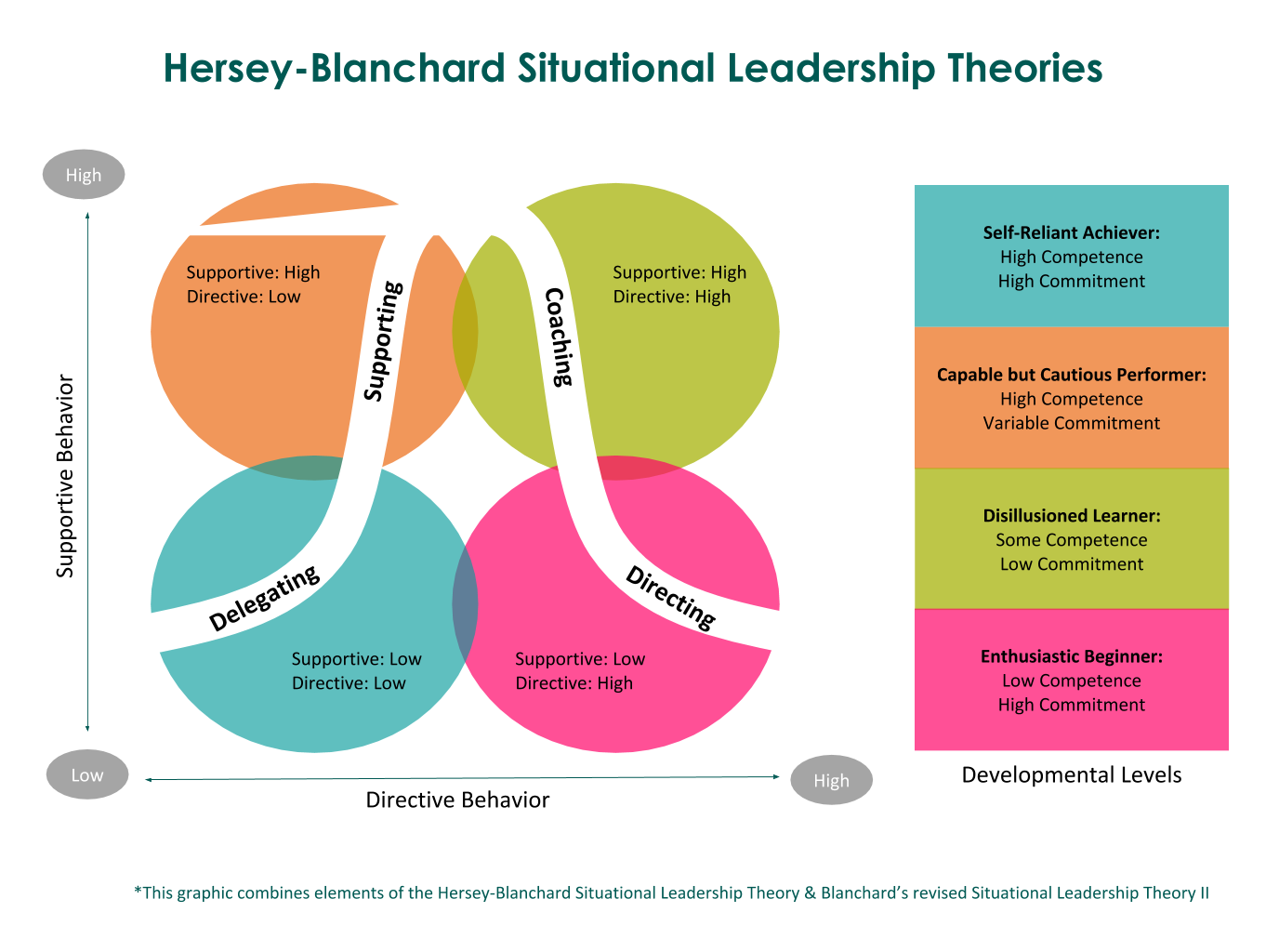Situational leadership is all about adapting your style to fit the needs of your team. Instead of sticking to one way of leading, you change your approach based on what your team members need at the moment. This makes it a great way to handle the fast changes and different types of workers you see today. In this guide, we’ll explore what situational leadership is, look at some real-life examples, and compare it to other styles of leadership.
Overview
- Situational leadership means changing your leadership style based on your team’s needs.
- It’s a flexible way to handle different challenges and types of workers.
- Real-life examples include leaders like Steve Jobs and Nelson Mandela.
- The Hersey-Blanchard model breaks situational leadership into four styles.
- Comparing situational leadership to other styles helps understand its unique benefits.
Table of contents
- Overview
- What is Situational Leadership Style?
- Rea-life Examples of Situational Leaders
- Situational Leadership Model by Hersey and Blanchard
- Comparing Situational Leadership Style with Other Leadership Styles
- Conclusion
- Frequently Asked Questions
- What is situational leadership?
- Who created the situational leadership model?
- What are the four leadership styles in situational leadership?
- How do you assess team development levels?
- Can situational leadership be used in any industry?
- What are the benefits of situational leadership?
- How does situational leadership compare to other leadership styles?
- What challenges might a leader face when using situational leadership?
What is Situational Leadership Style?
Situational leadership is an adaptive leadership style where leaders change their approach based on the individual, the task, and the context they’re managing. Developed by Ken Blanchard and Paul Hersey, this theory shifts the focus from “Who am I and how do I lead?” to “Who is the person in front of me, and what do they need from me to be successful?” This flexibility allows leaders to be highly effective across various contexts.
Situational leaders adjust their management style to ensure they are leading in the most appropriate and successful way. They need to be nimble and have a keen understanding of when to change up their leadership style depending on the business scenario—the situation.
- Adjusts leadership style to best fit any given situation: Situational leadership recognizes that different scenarios require different leadership approaches.
- Builds a strong relationship with team members: Situational leadership promotes strong relationships between leaders and team members by demonstrating the leader’s commitment to understanding and supporting each individual’s needs.
Situational leadership is about how leaders lead in different situations. Initially developed by Paul Hersey and Ken Blanchard in the late 1960s, the concept is based on the idea that leadership is not a one-size-fits-all approach – rather, one is encouraged to be agile, flexible, and responsive to the needs of the people they manage and the tasks at hand. As such, leaders are called to adapt their style based on their team’s maturity or readiness, depending on the specific state of affairs.
Rea-life Examples of Situational Leaders
Situational Leadership examples are all around you. Just think back to early in your career. Did you have a manager who explained things to you, guided you, and helped you in your role? When you didn’t have much experience, this type of management style could have been instrumental to your success and career growth.
To better understand the application of situational leadership, let’s explore some real-life examples that illustrate how successful leaders have adapted their approach to different scenarios.

Navigating a Crisis: The Directing Approach
When a global pandemic hit, the CEO of a large manufacturing company was faced with the challenge of keeping the business afloat and ensuring the safety of her employees. Recognizing the urgent need for decisive action, she adopted a directing leadership style. She quickly implemented strict safety protocols, streamlined decision-making processes, and provided clear instructions to her team on how to navigate the crisis. This directive approach allowed the company to respond swiftly and effectively, minimizing disruptions and safeguarding the well-being of the workforce.
Developing a High-Potential Employee: The Coaching Approach
A marketing manager noticed that one of his team members, a recent college graduate, had immense potential but lacked the confidence and experience to take on more challenging projects. Recognizing this, the manager adopted a coaching leadership style. He regularly provided feedback, offered guidance, and created opportunities for the team member to stretch their skills. Over time, the employee’s competence and commitment grew, and they were able to take on more responsibility and contribute to the team’s success in a meaningful way.
Owering a Seasoned Team: The Delegating Approach
The head of a software development team was leading a group of highly experienced and skilled engineers. Recognizing their expertise, he opted for a delegating leadership style. He clearly communicated the project goals, provided the necessary resources, and then stepped back, allowing the team to take full ownership of the work. This approach empowered the team members, fostered a sense of autonomy, and enabled them to leverage their knowledge and problem-solving skills to deliver exceptional results.
Situational Leadership Model by Hersey and Blanchard
The situational leadership model, created by Paul Hersey and Ken Blanchard in 1969, is a well-known framework in the world of leadership. It emphasizes that there is no single best way to lead. Instead, leaders should adapt their style based on the situation and the readiness of their team. This model has been widely adopted by many Fortune 500 companies and has had a significant impact on how modern organizations approach leadership.
Understanding the Four Leadership Styles
The situational leadership model outlines four main styles: directing, coaching, supporting, and delegating. Each style is suited to different levels of team development and task complexity. For example, a directing style is best for teams that need clear instructions and close supervision, while a delegating style works well for teams that are highly skilled and motivated.
- Directing: The directing style is characterized by a high degree of task-orientation and a low level of relationship-orientation. Leaders who adopt this style provide clear instructions, closely monitor progress, and make decisions on behalf of the team. This style is often employed when team members are new to a task or lack the necessary skills and experience to work independently.
- Coaching: The coaching style blends a high level of task-orientation with a high level of relationship-orientation. Leaders who use this style provide guidance, support, and feedback to help team members develop their skills and confidence. This style is particularly effective when team members are somewhat competent but lack the necessary commitment or motivation to complete a task.
- Supporting: The supporting style is marked by a low level of task-orientation and a high level of relationship-orientation. Leaders who use this style focus on creating a collaborative environment, empowering team members, and providing emotional support. This style is often employed when team members are competent but may lack the confidence or motivation to work independently.
- Delegating: The delegating style is characterized by a low level of both task-orientation and relationship-orientation. Leaders who use this style assign tasks to team members and provide minimal oversight, allowing them to work independently. This style is typically used when team members are highly competent and motivated, and can take full ownership of their responsibilities.

Assessing Team Development Levels
To effectively use the situational leadership model, leaders must assess their team’s development levels. This involves evaluating their competence and commitment to the task at hand. By understanding where their team stands, leaders can choose the most appropriate leadership style to guide them.
Implementing the Model in Your Organization
Implementing the situational leadership model in your organization involves several steps:
- Assess the readiness of your team members.
- Adapt your leadership style to match their development level.
- Communicate clearly and provide the necessary support and direction.
- Evaluate and adjust your approach as your team grows and changes.
Bold: The power of symbolic leadership in modern organizations – explore mastery. Delve into symbolic leadership’s impact on organizational culture and its future in the digital age.
By following these steps, leaders can create a more dynamic and responsive leadership approach that meets the needs of their team and drives success.
Comparing Situational Leadership Style with Other Leadership Styles
Situational Leadership vs. Transformational Leadership
Transformational leadership focuses on inspiring and motivating long-term change, while Situational leadership is about adapting to the needs of the moment. Situational leaders adjust their approach based on the situation, whereas transformational leaders aim to create a vision and guide their team towards it. For example, a situational leader might switch from a directive style to a supportive one as their team becomes more competent, while a transformational leader consistently works to inspire and elevate their team.
Situational Leadership vs. Transactional Leadership
Transactional leadership is often contrasted with situational leadership due to their stark differences. Situational leaders adapt their style to fit the context, while transactional leaders rely on a system of rewards and punishments to manage their team. A situational leader might change their approach to meet the needs of a project, whereas a transactional leader would stick to established protocols and incentives.
Situational Leadership vs. Servant Leadership
Servant leadership prioritizes the needs of the team above all else, focusing on serving others to achieve results. In contrast, situational leadership is more flexible, adjusting to the needs of the situation. A situational leader might take a directive approach in a crisis but switch to a more supportive role as the team stabilizes. Meanwhile, a servant leader consistently puts the team’s needs first, regardless of the situation.
Situational Leadership vs. Autocratic Leadership
Autocratic leadership involves making decisions unilaterally, with little input from team members. Situational leadership, on the other hand, involves adapting one’s style to the needs of the team and the situation. An autocratic leader might make all the decisions in a high-pressure situation, while a situational leader would assess the team’s readiness and choose the most appropriate leadership style.
Situational Leadership vs. Democratic Leadership
Democratic leadership encourages team participation in decision-making, fostering a sense of collaboration and shared responsibility. Situational leadership, however, is about choosing the right style for the moment. A situational leader might use a democratic approach when the team is experienced and capable, but switch to a more directive style when quick decisions are needed.
Situational leadership is unique because it requires leaders to be versatile and adaptable, constantly assessing and responding to the needs of their team and the situation at hand. This flexibility can make situational leaders highly effective across various contexts.
To develop a situational leadership style, leaders should practice assessing their team’s development levels and adjusting their approach accordingly. This involves being observant, flexible, and willing to change tactics as needed.
Conclusion
Mastering situational leadership is essential for today’s leaders. This approach teaches us that there isn’t a single best way to lead. Instead, effective leaders adapt their style to fit the needs of their team members and the tasks at hand. By using the four styles—directing, coaching, supporting, and delegating—leaders can help their teams grow and succeed. Embracing situational leadership means being flexible and responsive, ensuring that every team member gets the support they need to thrive. As the workplace continues to evolve, this adaptable leadership style will remain a valuable tool for guiding teams through new challenges and opportunities.
Frequently Asked Questions
What is situational leadership?
Situational leadership is a way of leading where the leader adjusts their style based on the needs and development level of their team members. It means being flexible and choosing the right approach for each situation.
Who created the situational leadership model?
The situational leadership model was created by Paul Hersey and Ken Blanchard. They developed it to help leaders adapt their style to the needs of their team.
What are the four leadership styles in situational leadership?
The four leadership styles in situational leadership are directing, coaching, supporting, and delegating. Each style is used based on the development level of the team members.
How do you assess team development levels?
To assess team development levels, you need to look at both the competence and commitment of your team members. This helps you decide which leadership style to use.
Can situational leadership be used in any industry?
Yes, situational leadership can be used in any industry. It’s a flexible approach that can be adapted to different work environments and team needs.
What are the benefits of situational leadership?
The benefits of situational leadership include better communication, improved team motivation, and more effective guidance. It helps leaders support their team members in the most appropriate way.
How does situational leadership compare to other leadership styles?
Situational leadership is unique because it focuses on flexibility and adapting to the needs of the team. Other styles, like transformational or autocratic leadership, may not be as adaptable.
What challenges might a leader face when using situational leadership?
A leader might face challenges like accurately assessing team development levels or choosing the right leadership style for each situation. It requires good judgment and flexibility.



